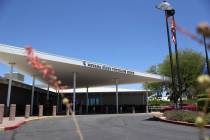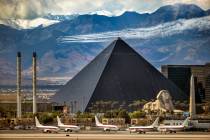Nellis sergeant recognized for daring rescue in Afghanistan

Rescuing people in dicey situations is what Air Force pararescue teams do for a living.
But when the bullets are flying and the team is in trouble, all those days and nights the members have spent training for the moment pay off, or at least they hope so.
That was the case on April 23, 2011, when Staff Sgt. Justin Tite, an aerial gunner on a Pave Hawk helicopter, was sent to a “hot zone” in eastern Afghanistan, about 20 miles east of Bagram Airfield.
This month, in a ceremony at Nellis Air Force Base, Maj. Gen. Bill Hyatt pinned a coveted Distinguished Flying Cross medal on Tite’s uniform for his actions of valor that he and the crew of the 33rd Rescue Squadron from Kadena Air Base, Japan, executed during a six-hour ordeal. During the mission, they rescued a couple of Army soldiers who were pinned down when an AH-64 Apache helicopter went down, in addition to another soldier who was later wounded in the firefight.
With a dozen bullet holes in their HH-60 Pave Hawk rescue helicopter, and after having to return to the base to get another one to complete the mission, they succeeded in rescuing two of the soldiers and recovering another from the battlefield.
“In our career field, we do extensive training throughout the year, day and night gunnery, pushing to the limits every time we fly,” Tite, 25, said by telephone Tuesday from the Nellis base, where he has been assigned since October to the 88th Test and Evaluation Squadron. The squadron tests new equipment and techniques for rescue teams.
“Once we actually got people on the ground and things started going not exactly as scripted, the training took over,” said Tite, a native of Jacksonville, Ill., who was raised in St. Louis.
Tite was an aerial gunner on the lead Pave Hawk in a two-ship formation.
“We send our PJs (pararescue jumpers) down. Once on the ground, they started taking enemy fire,” he said, adding that a flight engineer who was operating a hoist was shot in the leg.
Just after the second helicopter inserted a pararescue team, it also came under attack. Then Tite’s job was to suppress the enemy fire.
“On one pass, Tite spotted enemy units attacking his teams. He returned fire, suppressing them and killing at least one insurgent,” according to the July 13 issue of Bullseye, a publication produced by the 99th Air Base Wing Public Affairs Office at Nellis.
Although Tite’s helicopter was severely damaged he continued to suppress the enemy despite multiple aircraft emergencies.
“In all honesty, I’m just humbled to get this,” he said after receiving the Distinguished Flying Cross.
“I don’t take this award necessarily because of just what I’ve done. I think it’s more or less for the rescue community itself. There are people out there right now doing the same exact missions day in and day out, doing the 24-hour operations in Afghanistan.”
In six years of flying, Tite has been deployed once each to Iraq and Korea and twice to Afghanistan. On his last four-month deployment, he received six air medals. He was involved in 120 sorties that helped save lives.
Contact reporter Keith Rogers at krogers@review
journal.com or 702-383-0308.


















